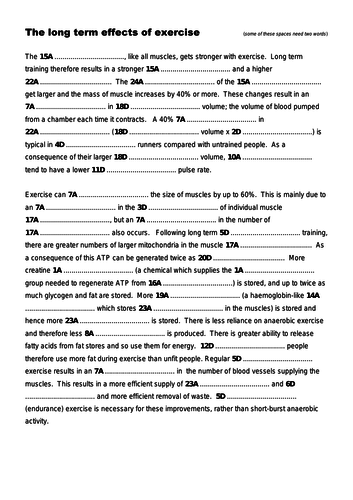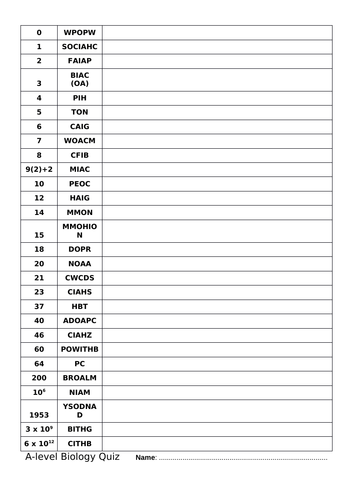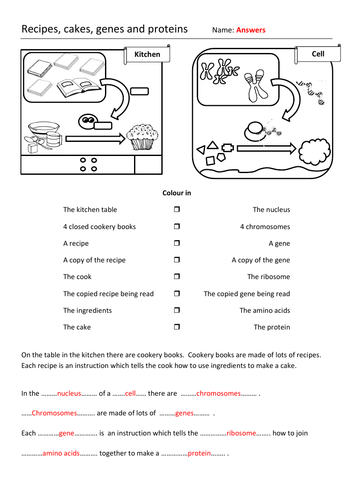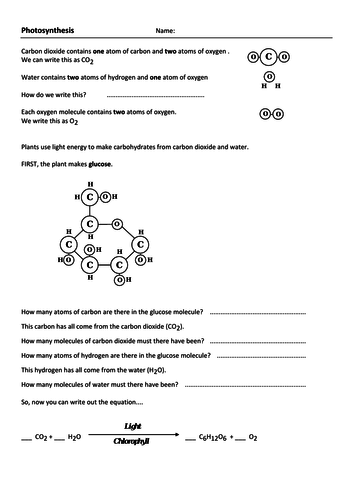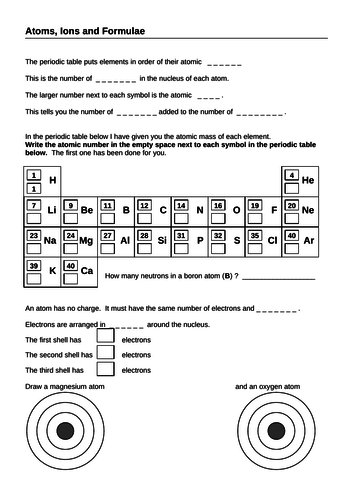68Uploads
29k+Views
34k+Downloads

Neurone labelling activity (GCSE)
Students colour in and label diagrams of motor and sensory neurones (nerve cells), identifying the axon, neuromuscular junctions, fatty sheath and dendrites. There are cloze (gap fill) questions alongside the diagrams. 2 pages, with answer sheet

The long term effects of exercise cloze/crossword (A-level)
This is a cloze activity with the words (2D, 24A) linking into a crossword. Covers fitness, heart rate, ATP production, breathing, oxygen uptake and muscle development. 2 pages with an answer sheet. Written to accompany A-level Biology.

A-level Core Biology Revision Quiz
We use this as a christmas revision quiz before Jan A-level trials.
Fun, competitive and a stress buster. Obviously needs reward for 1st completed etc.
0 = WPOPW (Water potential of pure water)
3 = BIAC (OA)
6 = CAIG
etc.

Genes and Proteins (Recipe, Cake analogy) GCSE
My lower ability GCSE students struggled distinguishing between genes ‘being’ the protein and genes ‘coding’ for the protein. The language was a barrier - weird, abstract words. This sheet uses a recipe-cake / gene-protein analogy with a bit of colour coding. The students enjoyed it and understood it. (I pointed out that medical students use colouring in to learn anatomy). Answers included

Photosynthesis - Equation & The uses of glucose (GCSE)
Worksheet with questions leading the students on to balance the equation for photosynthesis and then looking at what the glucose is used for in the plant. Double sided accompanied by an answer sheet

24 piece DNA, Genes and Chromosomes revision hexagon puzzle
Triangle puzzle on ‘DNA, genes and chromosomes’ where students match sentence fragments to construct a large hexagon. It is a revision activity which works across the ability range and is enjoyed by students. Weaker students need hints! It could be used for groups of three, and it works well as a race. An answer sheet is provided. Written to support A-level Biology.

Nuclear radiation: Self-marking excel spreadsheet/worksheet (GCSE).
This looks at alpha/beta/gamma radiation. An onscreen cloze/labelling activity written in Excel; it ticks each word as students get them correct. Students like it because it gives immediate feedback. I’ve used it with all ability groups at GCSE. If you want to work out how it’s done, the password to unprotect it is ‘eliziczac’. Save as a template to stop students overwriting the original. Works well on a VLE.

AQA Science subject specific vocabulary cue cards
36 Cue cards for AQA 9-1 GCSE Science (and AQA A-level Biology) Subject Specific Vocabulary.
Word on one side, definition from the exam board guidance on the other.
I’ve used them on the VLE.
When printing: flip on short edge

Lipids (A-level Biology) - Crossword; Question sheet; Structures info sheet
A set of resources I wrote to support Year 12 students learning about lipids.
The crossword is linked to a cloze activity: “Lipids are made of three 7A … joined with 3A… bonds to a 6A … molecule” etc. The question sheet is a double sided summary to test what they’ve learnt. The structure sheet lays out the structures of lipids, phospholipids, ways of representing them, ester bonds and saturated/unsaturated.

B2(D): Digestion Glossary and 2 Crosswords (AQA 9-1 GCSE Science)
Organisation (Digestion) Glossary: Written for AQA 9-1 GCSE Science but it would relate to other specifications. I wrote it by going through the syllabus/textbooks and picking out a mixture of key words and words which I thought students might not know. I’ve put in student-friendly definitions. It covers the digestion part of the topic which we teach separately from the transport and non-communicable parts.
There are two crosswords (about 20 words in each), based directly on the glossary. I tend to give neighbouring students different crosswords and so avoid too much copying. They are about the same difficulty so could be used competitively. They are deliberately straightforward to test the extent to which they have learnt the vocabulary.

B2(T): Transport Glossary and 3 Crosswords (AQA 9-1 GCSE Science)
Organisation (Transport / Non-communicable Disease) Glossary: Written for AQA 9-1 GCSE Science but it would relate to other specifications. I wrote it by going through the syllabus/textbooks and picking out a mixture of key words and words which I thought students might not know. I’ve put in student-friendly definitions. It covers the transport and non-communicable disease part of the topic which we teach separately from the digestion parts.
There are three crosswords (about 20 words in each), based directly on the glossary. I tend to give neighbouring students different crosswords and so avoid too much copying. They are about the same difficulty so could be used competitively. They are deliberately straightforward to test the extent to which they have learnt the vocabulary.
Answer keys are included.

B1 Cell Biology Glossary and 3 crosswords (AQA 9-1 GCSE Science)
Cell Biology Glossary: Written for AQA 9-1 GCSE Science but it would relate to other specifications.
Three crosswords (20+ different words in each), based directly on the glossary. I give neighbouring students different crosswords and so avoid too much copying. They are about the same difficulty so could be used competitively. They are deliberately straightforward to test the extent to which students have learnt the vocabulary.

Flower structure
Students use a crossword to label a diagram of a flower (sepal, petal, stigma, stamen, ovary, carpel etc). Two versions: one basic (omitting androecium, calyx etc), the other more testing. Can be used following flower dissections - students who finish first get on with the crossword. Answer sheets provided.
I’ve used it with whichever aged students I happen to be dissecting flowers with.

B4: Bioenergetics Glossary and 2 Crosswords (AQA 9-1 GCSE Science)
Bioenergetics Glossary: Written for AQA 9-1 GCSE Science but it would relate to other specifications. I wrote it by going through the syllabus/textbooks and picking out a mixture of key words and words which I thought students might not know. I’ve put in student-friendly definitions. It covers the transport and non-communicable disease part of the topic which we teach separately from the digestion parts.
There are two crosswords based directly on the glossary. I tend to give neighbouring students different crosswords and so avoid too much copying. They are about the same difficulty so could be used competitively. They are deliberately straightforward to test the extent to which they have learnt the vocabulary.
Answer keys are included.

B3: Infection Glossary and 2 Crosswords (AQA 9-1 GCSE Science)
Infection and Response Glossary: Written for AQA 9-1 GCSE Science but it would relate to other specifications. I wrote it by going through the syllabus/textbooks and picking out a mixture of key words and words which I thought students might not know. I’ve put in student-friendly definitions. It covers the transport and non-communicable disease part of the topic which we teach separately from the digestion parts.
There are two crosswords based directly on the glossary. I tend to give neighbouring students different crosswords and so avoid too much copying. They are about the same difficulty so could be used competitively. They are deliberately straightforward to test the extent to which they have learnt the vocabulary.
Answer keys are included.

Balancing combustion equations (Structured powerpoint for students to edit)
This is an 8 slide structured powerpoint for students to edit. It looks at balancing simple equations. It deals, as you’d expect, with numbers of molecules, numbers of atoms, subscript, conservation of atoms. I wrote it to accompany a GCSE module on combustion and air pollution. It is in the form of a workbook where students can edit the powerpoint presentation; moving atoms around (copying and pasting as necessary). There is a worked example to start with and the slides get harder. It works well on a smartboard. For lower ability students it is better done in smaller chunks. It could be used as a homework if put on a VLE. A powerpoint with the answers is included (useful for self/peer marking).

Structure, bonding and the mole. 13 slide powerpoint for students to edit. (GCSE)
A revision activity for students which uses editing a colourful powerpoint as a hook to get them into the science of moles, bonding etc. It works well with students who find moles too abstract. Students open it within powerpoint to edit the slides before viewing as a slideshow. I’ve used it with very weak KS4 groups. It can easily be edited to suit any syllabus: exercises cover bonding, compounds, the Periodic Table, calculating molar mass of compounds etc. An answer powerpoint is provided. It could easily be used as a homework on the VLE.

Atoms, ions and formulae. (3 side worksheet which deals with ionic compounds) (GCSE)
A revision worksheet for GCSE students. It shows how the charge of an ion and the position in the periodic table are related to atom structure. It leads them from this to working out formulae. I’ve used it with groups across the ability range.
Also included a summary sheet for the charges on ions

Regulation of blood glucose (A-level). 20 slide powerpoint, notes, two worksheets and a crossword
Animated, interactive powerpoint explaining glucose regulation and diabetes. Animations take students through the effects of hormones on liver/adipose/muscle cells (inc. carrier proteins / cAMP). The worksheets (including a crossword) complement the powerpoint. There is a ‘notes’ worksheet included so that students don’t need to copy the diagrams. Answer sheets included.

Polymers: Hexagon revision puzzle and Self-marking excel worksheet (GCSE)
Triangle puzzle on polymers where students match sentence fragments to construct a large hexagon. It is a revision activity which works across the ability range and is enjoyed by students. This could be used for groups of three, and it works well as a race. An answer sheet is provided.
Introduction to refining and polymerisation. An onscreen cloze/labelling activity written in Excel; it ticks each word as students get them correct. Students like it because it gives immediate feedback. I’ve used it with all ability groups at GCSE. If you want to work out how it’s done, the password to unprotect it is ‘eliziczac’. Save as a template to stop students overwriting the original. Works well on a VLE.




